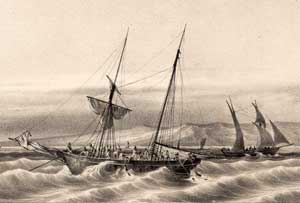Tsunami, 1756
 “This island (La Palma) has not been exempted from volcanos, the effects of which are still to be seen in almost every part of it; for the channels where the burning matter, melted ores, and calcined stones and ashes ran are easily distinguished. In the memory of some of the oldest inhabitants living in 1750, one of those fiery rivers ran down from the mountains toward the town of Santa Cruz, and emptied itself into the sea about a mile to the northward of the town. No considerable earthquake hath happened in those islands for some years past, but now and then they have some slight shocks: they had some at the time of the memorable earthquake at Lisbon, but they were scarce perceptible: only the sudden flux and reflux of the sea was evident enough, at Porto de Luz, in Canaria, where the sea went about a mile back, and remained there for some time. The people of Palma at that time seeing a wreck lying upon the ground, which the water had left bare, some of them were so bold as to go to it, but the sea suddenly returning, swept them all away. A boatman at Port Orotava told me, that on the day of the Lisbon earthquake, his boat was hauled up on the beach, and he was leaning upon it, conversing with some fishermen on the strand, when all on a sudden the sea floated his boat, and wetted him and his companions to the middle; then retiring a great way back, it returned again, but not with such violence as at first; and to continue ebbing and flowing for the space of an hour.”
“This island (La Palma) has not been exempted from volcanos, the effects of which are still to be seen in almost every part of it; for the channels where the burning matter, melted ores, and calcined stones and ashes ran are easily distinguished. In the memory of some of the oldest inhabitants living in 1750, one of those fiery rivers ran down from the mountains toward the town of Santa Cruz, and emptied itself into the sea about a mile to the northward of the town. No considerable earthquake hath happened in those islands for some years past, but now and then they have some slight shocks: they had some at the time of the memorable earthquake at Lisbon, but they were scarce perceptible: only the sudden flux and reflux of the sea was evident enough, at Porto de Luz, in Canaria, where the sea went about a mile back, and remained there for some time. The people of Palma at that time seeing a wreck lying upon the ground, which the water had left bare, some of them were so bold as to go to it, but the sea suddenly returning, swept them all away. A boatman at Port Orotava told me, that on the day of the Lisbon earthquake, his boat was hauled up on the beach, and he was leaning upon it, conversing with some fishermen on the strand, when all on a sudden the sea floated his boat, and wetted him and his companions to the middle; then retiring a great way back, it returned again, but not with such violence as at first; and to continue ebbing and flowing for the space of an hour.”
George Glas

